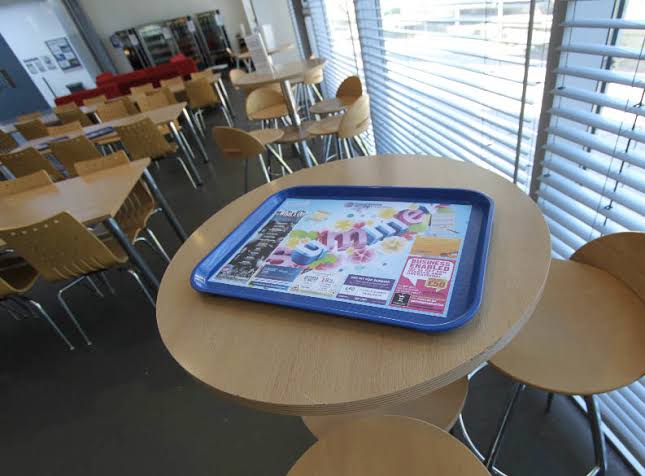Advertise where the focus is real, and the audience is hungry! With placemat ads, your message gets 15-30 minutes of full attention while diners wait for their meals. Why settle for a fleeting billboard glance when you can have an engagement over dinner?
Placing advertisements directly onto placemats or tabletop surfaces in restaurants is an example of placemat and tabletop advertising. This style of advertising gives firms the opportunity to attract the attention of customers while they are waiting for their meals. The reason that this type of ambient advertising is so successful is that it takes advantage of a laid-back environment in which buyers are exposed to the advertisement for a longer period of time, typically for fifteen to thirty minutes or even more. During mealtimes, customers are a captive audience, and it is difficult to ignore advertisements because they are positioned directly in front of them during mealtime.
How It Gets Done
The use of branded placemats or advertisements that are placed directly on table surfaces by restaurants provides businesses with the opportunity to display their message in a manner that is not intrusive. During the time that they are waiting for their food, customers frequently gaze at the placemat, which provides them with sufficient opportunity to take in the message, whether consciously or subconsciously. This generates a high level of engagement as well as brand memory.
Understanding Consumer Psychology in Placemat Advertising
Placemat and tabletop advertising taps into specific consumer psychology principles by engaging audiences in a relaxed, attentive setting: restaurants. When diners sit down at a table, they become a captive audience, making them more receptive to brand messaging displayed in their immediate environment.
Captive Audience and Heightened Focus
Unlike many advertising mediums where consumers are often in motion—like driving past billboards, scrolling on social media, or watching television—restaurant patrons are typically stationary and waiting. This waiting time offers an organic opportunity for ad exposure, especially when diners are anticipating their meal or chatting with minimal distractions. Research on consumer attention indicates that individuals tend to focus more on their surroundings during periods of waiting. Placemat ads leverage this tendency, capturing diners’ attention for a sustained period, often between 15 and 30 minutes.
The natural behavior of scanning the environment while waiting increases the chance that diners will notice the ad. This habit stems from the brain’s desire to stay engaged, especially in new or public settings. Diners may subconsciously fixate on the placemat for visual stimulation, leading to repeated exposure and solidifying the brand in their minds, even when they aren’t actively interacting with it.
The Role of Boredom and Repeated Exposure
Placemat ads also harness the power of boredom to drive attention. When people are waiting for food, they are more likely to notice and engage with the advertising in front of them. Boredom serves as a motivator, encouraging them to seek stimulation, including through ads. This effect heightens ad memorability.
Combined with repetition, placemat ads ensure that diners are exposed to the message multiple times within a short period. Repetition is a proven advertising tactic for boosting brand recall and recognition. Studies in consumer psychology show that the more frequently consumers see an ad, the more familiar it becomes, fostering positive associations with the brand and building trust. The calm setting of a restaurant allows patrons to view the same ad multiple times without feeling overwhelmed or annoyed.
Subconscious Processing and Incidental Learning
Placemat ads also activate incidental learning. Even if diners aren’t actively looking at the ad, their subconscious is processing the information. This passive form of learning can be surprisingly effective. Research suggests that people retain information presented unobtrusively during idle moments, like waiting for food.
This subconscious engagement creates an environment where consumers grow familiar with the brand or product without any pressure to react immediately. Because the ads are woven into the dining experience, they can lead to stronger brand recall and more favorable attitudes compared to more forceful advertising approaches.
Social Interaction and the Power of Word-of-Mouth
Dining is usually a social activity, especially in family-oriented restaurants, making social interaction a key element of the restaurant experience. Placemat ads can naturally spark conversation among diners. For instance, someone might point out an ad, leading to a discussion about the brand, thereby generating word-of-mouth engagement.
Word-of-mouth has long been one of the most trusted forms of advertising, as consumers value recommendations from their peers more than traditional ads. By prompting these organic conversations, placemat ads allow brands to expand their reach and influence within social circles.
Positive Emotional Context and Brand Association
Dining out is often associated with positive emotions like relaxation, enjoyment, and social connection. This emotional setting can amplify the effectiveness of placemat ads, as consumers are more likely to associate the brands they see with these positive feelings.
This concept, known as emotional priming, suggests that consumers are more receptive to brands encountered in a pleasant environment. The positive emotions experienced while dining can transfer to the advertised brands, creating a “halo effect.” This effect makes consumers more likely to remember the brand fondly and increases the likelihood of future purchases.
Conclusion
Placemat advertising offers a unique opportunity to tap into consumer psychology through the principles of boredom, repetition, incidental learning, and emotional priming. By engaging diners in a low-pressure, attentive setting, placemat ads can significantly boost brand recall and influence consumer choices. Brands can harness these behavioral insights to form deeper, more lasting connections with their audience.
We dive deeper into the advantages of this innovative advertising approach, exploring its cost-effectiveness and how it stacks up against other media options, in our additional blog posts.







